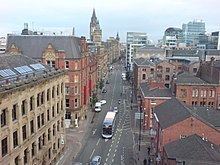 | ||
Ibis manchester centre princess street manchester england united kingdom
Princess Street is one of the main streets in the city centre of Manchester, England. It begins at Cross Street and runs approximately eastwards across Mosley Street, Portland Street and Whitworth Street until the point where it continues as Brook Street and eventually joins the A34.
Contents
- Ibis manchester centre princess street manchester england united kingdom
- Map of Princess St Manchester UK
- History
- Route
- Notable buildings
- References
Map of Princess St, Manchester, UK
History
It is not clear whether the street was actually named after a princess and the second part of it once bore the name of David Street. Originally a residential street it became the site of many textile warehouses and large office buildings during the 19th century. Some of these have since been demolished but most have been converted to other uses.
Route
Southbound, the road is one-way as it passes Albert Square, St Peter's Square and its tram stop. After Major Street it becomes two-way and crosses the River Medlock and the Rochdale Canal before going under the Mancunian Way and terminating when it becomes Brook Street.
